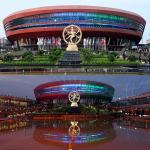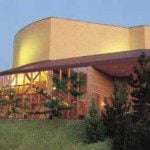RAM RATH YATRA IN THE UNITED STATES AND ITS SIGNIFICANCE
We include a brief description of RRY, its spiritual, religious, cultural, and political dimensions, and history. The photos from three different Mandirs in Minnesota with author’s affiliation are included although only one of the three was personally visited on May 24 at the Milan Mandir in the rural Farmington, MN community. A glimpse of the highlights of the breathtaking and historical RRY in Mandirs across the United States is available as a video from Bharat Media LLC.
THE RATH YATRA:
The Rath is “chariot” and Yatra translations include “journey,” “procession,” or “pilgrimage.” The combined phrase Rath Yatra holds a greater significance in Hindu traditions. It is associated with pilgrimage that involves a procession of Bhagwan Murtis (deities) in chariots through the streets. The largest celebration takes place at the Jagannath Temple in Puri, India but Hindu communities have local Rath Yatra for different festivals/Gods.
RRY AND THE OLYMPIC TORCH:
The 2024 RRY is not only similar but more than the Olympic torch. The latter originates in Olympia, Greece and carries the message of hope, peace, and unity. The epicenter of RRY is Ayodhya, where Ram Lalla, symbolically the Olympic torch, is the epitome of righteousness (dharma), virtue, and ideal kingship. He embodies compassion, humility, and selflessness, as well as unwavering truth, justice, and moral values. He is known to fulfill his duties with utmost sincerity and remains steadfast in the face of adversity.
The RRY, according to its organizer (VHP of America), was aimed at uniting Hindus and to raise awareness, educate, and empower, especially the future generation, about Hindu Dharma. It is critically important to stay united and strong in the midst of increasing incidences of anti-Hindu sentiments and Hinduphobia in the U.S. institutions influencing Hindu youth. A strong message about the virtues of Bhagwan Ram will certainly make a positive impact on our youth in the West.
The RAM RATH YATRA:
The modern rath in America was a Toyota Sienna minivan with murtis (statues), especially Ram Durbar (Lord Ram, Goddess Sita, Lord Lakshman, and Lord Hanuman) and Ram Lalla. The rath had special prasad (blessed offerings), a kalash (container) of the Prana Pratishtha, and akshat (sacred rice) from Ayodhya. About one-hour long puja (religious rituals) was performed in each Mandir and the prasad and akshat shared with local communities. The puja followed a protocol including the procession of Ram Lalla and installation (symbolic Pran Pratishtha) for the community celebration.
The RRY started in Chicago, symbolizing Ayodhya for the Hindu faithful and Olympia for the rest of the humanity, carrying the message of Vasudaiva Kutumbakam. It started on March 23, the auspicious day of HOLI, the festival of colors celebrated by Hindus.
What was planned to be a 60-day expedition covering more than 16,000 miles grew by the day as more Mandirs expressed interest in hosting RRY for their devotees. It is worth mentioning that Canada has its own version of RRY and thus making it a North American event.
The General Secretary of VHPA, Amitabh Mittal, told the author on May 24 that Ram Rath Yatra had already traveled more than 22,200 miles visiting over 850 Mandirs across the United States since leaving Chicago. The RRY still had several more temples in MN and WI before heading back to Chicago on May 25, nearly two months after the beginning of the divine journey in March.
Mittal said that Bhagwan Ram also traveled to Alaska by air in addition to road journey to forty-four states. The determination and stamina of Ram Bhaktas (devotees) and VHPA volunteers on the road for two months is incredible. It is truly their undeterred devotion and abiding faith in Bhagwan Ram and a tremendous service to Hindus and the communities at large. Imagine yourself visiting on average 14 Mandirs , driving about 370 miles, performing puja, and meeting different people each day for two months. Decidedly, an incredible feat for VHPA and its dedicated team members.
ANOTHER PARALLEL WITH OLYMPIC TORCH
The RRY traveled over 22,000 miles on the narrow streets and highways of America to reach Hindu Mandirs in smaller and larger cities. According to an archived article, the longest journey of 15,000 miles of the Olympic flame across America was in 1996. For 2024 Olympic in France, the flame journeyed through Greece covering about 5,000 kilometers (~ 3125 miles). Then it travelled 12,000 kilometers (7500 miles) in mainland France and its overseas territories in the Caribbean, Indian Ocean, and Pacific. Thus, the RRY has the distinct edge in the distance travelled by the Olympic flame. It may also be noted that the Olympic torch is carried by thousands of athletes for shorter distances while RRY included only a handful Ram devotees throughout the longest road travel.
RRY in Minnesota Mandirs:
Minnesota is home to many Hindu places of worship and Hindu teachings extending from Moorhead bordering North Dakota to Rochester bordering Wisconsin. On March 24, Ram Rath had its morning rendezvous at the Hindu Temple of Fargo-Moorhead, late afternoon at the Hindu Temple in Maple Grove, and late evening visit at the Minnesota Hindu Milan Mandir. The author attended RRY at the last destination in a rural Farmington community. The author surmises that the ceremonies were similar at all locations but the devotee crowd varied depending on the time of the day and number of Hindus in that community. The following photo gallery shows RRY ceremonies in three places with authors’ affiliation but most importantly it is his abiding faith in Hinduism and Sanatan Dharma and thus with all Hindu places of worship.
BRIEF HISTORY AND POLITICAL SIGNIFICANCE:
Ayodhya is Ram’s birthplace with the newly constructed Ram Mandir signifying a momentous victory for all Hindus. The Hindus at last, under the current leadership of Bhartiya Janata Party (BJP), won the legal battle after nearly 500 years since a mosque was built by the then Jihadist invaders and rulers of India. While Modi-Yogi team deserves credit in the present, Lal Krishna Advani, the then president of BJP, and Ashok Singhal leading Vishwa Hindu Parishad (VHP) in the 1990s spearheaded the campaign for regaining the Ram Janma Bhoomi.
Advani is credited for the RRY in 1990 in India with tacit support by VHP and other Hindu affiliates. Advani and hundreds of agitators were arrested and the violent agitations took many lives in different parts of Bharat, that is India. The apparent agitation may have been subdued by the then governments but the underneath flame caught fire and continued. In 1992, the longstanding Hindu warrior Singhal led the movement in which the Babri Mosque was razed. Had it not been for Advani and Singhal, neither BJP may have emerged a strong political party nor there will be a Ram Mandir.
The BJP has continued its steady political presence and influence to date. Three successive terms, Modi 1.0 in 2014, Modi 2.0 in 2019, and unstoppable Modi 3.0 in 2024 are equally historical. The contemporary Ram Mandir seed planted in the Nineties started growing with greater speed and scale. Finally, nearly 1.5 billion Hindus worldwide celebrated the consecration of Ram Lalla Mandir on January 23, 2024.
Hindu’s abiding faith (Aastha) in Ram was always unwavering but it peaked to unprecedented heights in the months since the meticulous and grand opening in January. The magnificent Ram Mandir orchestrated as much a strong religious celebration as a strong rallying point for 2024 elections in Bharat. There was hardly any political event in which BJP leaders did not use Jai Shri Ram as the strong slogan to rally around and invoke ‘Aastha’ in Bhagwan Ram.













